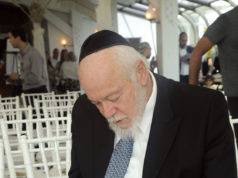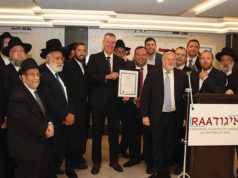
Recently, David Harris, the Executive Director of the American Jewish Committee (AJC) made the opening remarks at a reunion between Soviet President Mikhail Gorbachev and former US Secretary of State George Shultz. When he was finished, Gorbachev publicly praised his words, saying Harris helped him gain a new understanding of the Jewish community’s view of Russian and Soviet Jewish history. Here is a portion of what David Harris had to say:
In 1974, I traveled to the USSR for the first time as part of a US-Soviet teachers’ exchange program. I was sent to School No. 185 in Leningrad.
Shortly after arriving, I was walking in the hallway when a young girl passed by and quietly put a piece of paper in my hand. When I was alone, I read the note. It said: “David Harris, I feel you are a Jew. If I’m right, please know that my family are refuseniks. Won’t you come visit us?”
I did. It was one of several such families I eventually met. Why did they want to leave? Her father, an engineer, explained that his children had no future in the Soviet Union. The barriers were too high, anti-Semitism too endemic.
So why were they denied the right to emigrate? The father told me a joke which was then making the rounds: Shapiro was called into KGB headquarters and told he would never be allowed to leave. “But why, Comrade Major?” he pleaded. “Because you know state secrets.” “What state secrets? In my field, the Americans are at least 10 years ahead of us.” “Well,” said the KGB major, “that’s the state secret.”
I asked the girl, who was about 14, why she thought I was Jewish and risked approaching me. She told me that in the USSR no one in their right mind would give a boy the first name David unless he was Jewish, or else they’d cripple him for life. She assumed it was probably the same in other countries. It’s why she and other students insisted that Abraham Lincoln was the first Jewish president. Nothing I said could convince them otherwise.
The plight of the engineer’s family was but one episode in a difficult history, involving millions and spanning centuries. It’s hard to know where the story begins. Perhaps in 1648, when the Ukrainian Cossacks went on a murderous rampage and killed as many as 100,000 Jews. Or in 1791, when Catherine the Great created the Pale of Settlement (a region of Imperial Russia in which permanent residence of Jews was allowed, and beyond which Jewish residence was generally prohibited), forcing Jews to live in this confined space for well over a century. Or in 1827, when Czar Nicholas I began conscripting Jewish boys into the army for a 25-year tour, during which every effort was made to convert them to Christianity.
Maybe it was in 1881, when the assassination of Czar Alexander II triggered a deadly wave of pogroms. Or that same year, when Konstantin Pobedonostsev argued that the Jewish problem could be solved only if one third of Russia’s Jews emigrated, one third converted, and one third perished.
Maybe it was in 1903, when the czarist secret police fabricated the infamous Protocols of the Elders of Zion, which claimed that Jews plotted to control the world. Or in 1917, when Jews were accorded equal rights, creating the short-lived hope that better times were ahead. Or in 1918, when that hope was proven illusory, as the Civil War resulted in an estimated 2,000 pogroms and tens of thousands of Jewish deaths.
Or maybe it was in the 1920s, when emigration was no longer possible, and it became clear that Jewish religious life in the Soviet Union would be proscribed. Or in the 1930s, the decade of the Great Terror, when many Jews were among the millions purged by Stalin.
Or in 1948, when Golda Meir, as Israel’s first ambassador to the Soviet Union came to Moscow’s only remaining synagogue, alarming the Kremlin when 50,000 Jews took to the streets to welcome her.
Or in those years when the first copies of Leon Uris’s Exodus, the story of Israel’s birth, began circulating in Russian awakening kinship with the Jewish state. Or in 1967, when Israel, faced with extinction by enemies armed with Soviet weaponry, vanquished the threat in just six days, electrifying Soviet Jews.
Or perhaps—perhaps—there wasn’t a precise date at all, just a sense for many that, despite Jews’ deep roots and love of Russian culture, something wasn’t right, and time alone wouldn’t make it any better. Maybe it was the recognition that prestigious universities and institutes were too frequently off-limits to Jews. Maybe it was the awareness that certain jobs were denied to Jews, and that Jews who had jobs had to work harder to prove that they deserved them.
Maybe it was the fear that Jewish children would be subjected to taunts and jeers in school, and that school officials wouldn’t defend them. Maybe it was the anguish that there were no memorials to the countless Jews slain by the Nazis on Soviet territory during the Holocaust.
Maybe it was the reality that Jews could not satisfy their most basic curiosity about being Jewish—history, religion, tradition, language—without endangering their families. Maybe it was the relentless demonization of Israel and vilification of Zionism in Soviet officialdom.
Whatever the cause, by 1971, there was a full-fledged Soviet Jewry movement in the USSR and a growing support network around the world. For the next two decades, history was written. Soviet Jews cried out in Russian, in Hebrew and they cried out in English for the world to hear the famous Biblical words, “Let my people go.”
These Soviet Jews, few in number at first, were extraordinarily brave. They challenged the might of the Soviet Union.
Couldn’t the Kremlin simply crush them, make examples of them? And hadn’t the word “emigration” been missing from the Soviet lexicon for decades? Repatriation to Israel, as the first activists demanded, seemed absurd. After 1967, there weren’t even diplomatic ties.
And yet, they weren’t crushed. Their numbers grew. The word “emigration” surfaced and Israel became the overwhelmingly preferred destination for those who began leaving in 1971.
Many paid a heavy price. Thousands were not fortunate enough to get permission to leave. Either they ended up in limbo, often for many years, as refuseniks or they became Prisoners of Zion, jailed for their activism and beliefs. But nothing deterred them and they knew they were not alone.
Jews from around the world, unwilling to sit silently while millions were once again targeted, organized, rallied, petitioned, fasted, lobbied, advocated and traveled. Governments responded, most notably the US and Israel, but others as well. For our country, the plight of Soviet Jews became a central item on our bilateral agenda and for the Congress.
Israel, despite the absence of direct links with the USSR, found many ways to give hope and support to Jews in the Soviet Union. The Helsinki Final Act, signed in 1975 by 35 nations, including the USSR and all of Europe, gave the Soviet Jewry movement an additional lever by calling for the protection of human rights.
Try as the Soviet Union might, it could not quell the growing storm of protest. If the Kremlin relaxed its stance on emigration, as it did in 1973 and 1979, more Jews rushed to seek permission to leave. If it tightened its stance, as it did after the Moscow Olympics in 1980, then the global outcry intensified.
And so we come at last to the Reagan-Gorbachev era. Few could have predicted its auspicious outcome. Certainly, when we were asked to organize a mass rally in Washington, on the eve of President Gorbachev’s first visit in 1987, little could we have foreseen the extraordinary events of the next four years.
And little could I have imagined, as the chief organizer for that rally, as the son of one of the last emigrants from the Soviet Union in the Stalin era, and as a person who was expelled from the USSR in 1974 because of my contact with Jews, that I would be here today in the presence of Mikhail Gorbachev.
We had about five weeks to organize the rally from scratch. The largest Jewish rally in Washington till then had only drawn 12-14,000 people, which didn’t give us much hope. Plus, it was slated for December, with its notoriously tricky weather. But Natan Sharansky, released from the Gulag the previous year, kept pushing our sights higher. We set a goal of 250,000 people, never really believing we’d reach it. In fact, we exceeded it. People from all walks of life came. They felt they had to be there. They understood that silence or indifference to human suffering is never an answer. And they were joined by Vice President Bush and a parade of Washington dignitaries.
Not too long afterwards, President Gorbachev opened the gates, and the Jews came streaming out. Of course, only President Gorbachev knows the degree to which this and other rallies and protests affected the decision-making of the Kremlin.
The knowledge that the US stood with them in their struggle was extraordinarily powerful. And there are few American officials who embody that support more than George Shultz. No words are sufficient to describe the central role he played, or the message he sent, when, as secretary of state, he hosted a Passover Seder for Soviet Jewish activists at the American Embassy in Moscow in 1987.
At a moment when the world needs symbols of hope and possibility, today’s lunch couldn’t be better timed. It’s a perfect reminder of the power of individuals to dream dreams and fulfill them, as Soviet Jews did; and of the capacity of true statesmen to chart a brighter future and achieve it, as our two distinguished guests did so magnificently.



